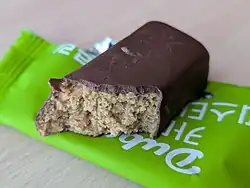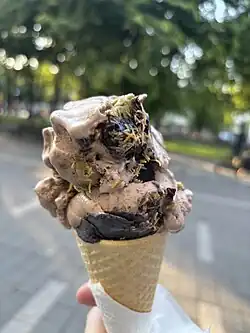Dubai chocolate
 A chocolate bar broken open to reveal green filling inside | |
| Type | Chocolate bar |
|---|---|
| Course | Dessert |
| Place of origin | United Arab Emirates |
| Region or state | Dubai |
| Created by | Sarah Hamouda |
| Invented | 2021 |
| Main ingredients | milk chocolate, pistachio, tahini, kadayif |
Dubai chocolate (Arabic: شوكولاتة دبي) is a style of chocolate bar filled with kadayif (chopped filo pastry) and a pistachio-tahini cream. It was created in 2021 by Fix Dessert Chocolatier, an Emirati chocolatier in Dubai.[1] Dubai chocolate was popularized in 2024 by influencers on social media, especially those on TikTok, and has since been imitated by vendors worldwide.
Description
Dubai chocolate is a milk chocolate bar filled with a sweet pistachio-tahini cream and kadayif (chopped filo pastry).[2] The consistency of the filling ranges from finely ground to a paste.[3] The creamy textures of the pistachio and tahini contrasts with the crunch of the kadayif.[2]
Creation
Dubai chocolate was invented in 2021 by Sarah Hamouda, a British-Egyptian engineer living in Dubai.[2][4] At the time, Hamouda was pregnant, and through her food cravings she came to imagine a combination of chocolate, pistachio, tahini, and knafeh, a Middle Eastern dessert made of kadayif, syrup and a soft cheese. At home, Hamouda worked on developing a bar, before contacting Nouel Catis Omamalin, a Filipino culinary consultant who had trained as a pastry chef.[2] In his account of Dubai chocolate's creation, Omamalin said the pair wanted to create a chocolate bar with the flavour of a dessert. As his favourite Arabic dessert was knafeh, and because he thought it would have an appealing crunch and nostalgic value, Omamalin suggested a chocolate bar using its flavours. Together, they developed the chocolate, forming a partnership and the online shop Fix Dessert Chocolatier,[5] which in 2022 launched "Can't Get Knafeh of It".[6]
Can't Get Knafeh contained pistachio, tahini and kadayif, and was covered in yellow and green patterns.[6] Bars were made by hand, the interiors piped; a team working six to eight hours would produce 25 bars a day. Omamalin, who had by the launch left the partnership, kept working with Hamouda, saying he was doing so "as a friend".[5] Over the following year, they continued to modify the recipe, until early 2023 when Hamouda said they had "finally... nailed it".[2] Each bar was sold for £16 (US$19.72), initially at a rate of one per week.[6]

With a small marketing budget, Fix relied on social media influencers to promote the chocolate, who tasted and reviewed it on camera. The interior's bright colors have been credited with some of the product's success, as the visual appeal created is important on social media platforms such as TikTok and Instagram.[3] It first gained popularity in 2024.[7][4]
Dubai chocolate gained popularity as manufacturers were facing high costs in producing cocoa and pistachio products. Due to the product's composition, manufacturing Dubai chocolate allowed them to keep costs down. Dubai was viewed as a trendy location among young people, particularly with social media influencers.[3]
Expansion

As the product gained popularity, large scale manufacturers such as Lindt began to produce and market them as Dubai Chocolate. In Germany, an importer of a clone of Fix Dubai Chocolate issued a cease-and-desist letter to the manufacturer Lindt, Aldi and Lidl because it was not produced in Dubai.[8] While geographical indications are in principle protectable under the Geneva Act of the Lisbon Agreement, the United Arab Emirates has not signed the agreement.[9] According to most legal scholars, the term "Dubai chocolate" is already a generic trademark in the EU market and does not contain any geographical indication.[10]
In January 2025, a German court in Cologne decided that Aldi has to stop selling its product named "Alyan Dubai Handmade Chocolate" on the ground it might mislead consumers that the chocolate has been produced in Dubai while it is actually produced in Turkey.[11] In the UK, the popularity of the Lindt variety of the chocolate was such that the supermarket chain Waitrose imposed purchase limits of two bars per customer.[3]
Studies and allergens
A study by the Baden-Württemberg Ministry of Consumer Protection tested eight imported samples of 'Dubai chocolate', five from the United Arab Emirates and three from Turkey. It found that all eight samples were considered "defective". Five of the products sampled contained fats other than cocoa butter, which is not permitted in products labelled "chocolate" in Germany. The study also found that five samples, all from the same producer in the UAE, were "unfit for consumption" due to contamination in the manufacturing process (they contained excessive levels of a substance that is considered a probable carcinogen, resulting from the use of low-quality palm oil). All three samples from Turkey were found to contain traces of undeclared sesame, usually as tahini, which may be dangerous for people allergic to sesame. A screening also revealed high levels of mold toxins (aflatoxins) in the pistachio component in one sample.[12][13]
See also
References
- ^ "From TikTok To Trade: How Dubai Chocolate's Viral Craze Sparked Global Pistachio Shortage". NDTV. 20 April 2025.
- ^ a b c d e Saner, Emine (April 8, 2025). "Sweet, sticky and sold out everywhere: why is there such a craze for Dubai chocolate?". The Guardian. Archived from the original on June 9, 2025. Retrieved July 15, 2025.
- ^ a b c d Spencer-Jolliffe, Natasha (4 April 2025). "Dubai Chocolate craze reaches fever pitch". Confectionery News. William Reed Ltd. Retrieved 8 April 2025.
- ^ a b Cairns, Rebecca (18 June 2024). "Meet the woman behind Dubai's viral super-chunky chocolate bar". CNN. CNN. Retrieved 16 December 2024.
- ^ a b Beltran, Samantha (September 30, 2024). "Meet the Filipino chef behind TikTok's viral Dubai chocolate bar". Arab News. Archived from the original on December 17, 2024. Retrieved July 15, 2025.
- ^ a b c Swain, Marianka (March 27, 2025). "The chocolate bar that's so popular Waitrose has limited the number it sells". The Daily Telegraph. Archived from the original on March 27, 2025. Retrieved July 15, 2025.
- ^ Michollek, Nadine (10 December 2024). "Trending treat 'Dubai chocolate' — but who owns the name?". dw.com. Deutsche Welle. Retrieved 16 December 2024.
- ^ Dietrich, Pauline (11 December 2024). "Muss "Dubai-Schokolade" aus Dubai kommen?". lto.de (in German). Legal Tribune Online. Retrieved 16 December 2024.
- ^ "Markenstreit um Dubai-Schokolade: Deutscher Importeur mahnt Hersteller Lindt ab". businessinsider.de (in German). Business Insider. 8 December 2024. Retrieved 21 December 2024.
- ^ Ullrich, Ann-Kathrin (14 December 2024). "Aldi und Lidl: Wegen Dubai-Schokolade! Jetzt kommt es knüppeldick". derwesten.de (in German). Der Westen. Retrieved 21 December 2024.
- ^ "'Dubai chocolate' must come from Dubai, German court rules – DW – 01/13/2025". dw.com. Retrieved 2025-02-14.
- ^ "Hype um "Dubai-Schokolade" – Was steckt wirklich drin?". Baden-Württemberg - The Food and Animal Health Inspection Offices (in German). 19 December 2024. Retrieved 31 December 2024.
- ^ KooDe (2024-12-19). "Dubai Schokolade: Auffälligkeiten bei Proben". ZDF Heute (in German). Retrieved 2024-12-29.
External links
 Media related to Dubai chocolate at Wikimedia Commons
Media related to Dubai chocolate at Wikimedia Commons